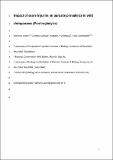Files in this item
Impact of snare injuries on parasite prevalence in wild chimpanzees (Pan troglodytes)
Item metadata
| dc.contributor.author | Yersin, Harmony | |
| dc.contributor.author | Asiimwe, Caroline | |
| dc.contributor.author | Voordouw, Maarten J. | |
| dc.contributor.author | Zuberbühler, Klaus | |
| dc.date.accessioned | 2017-12-23T00:32:00Z | |
| dc.date.available | 2017-12-23T00:32:00Z | |
| dc.date.issued | 2017-02 | |
| dc.identifier | 248698571 | |
| dc.identifier | 07a31bbf-dafe-43da-8298-98ae5234a814 | |
| dc.identifier | 85006857191 | |
| dc.identifier | 000394370000002 | |
| dc.identifier.citation | Yersin , H , Asiimwe , C , Voordouw , M J & Zuberbühler , K 2017 , ' Impact of snare injuries on parasite prevalence in wild chimpanzees ( Pan troglodytes ) ' , International Journal of Primatology , vol. 38 , no. 1 , pp. 21-30 . https://doi.org/10.1007/s10764-016-9941-x | en |
| dc.identifier.issn | 0164-0291 | |
| dc.identifier.other | ORCID: /0000-0001-8378-088X/work/64360725 | |
| dc.identifier.uri | https://hdl.handle.net/10023/12384 | |
| dc.description | We thank the Royal Zoological Society of Scotland for providing core funding to the BCFS. We thank the ARCUS Foundation for funding the Chimpanzee Monitoring Programme. Funding for fieldwork was provided by the Institute of Biology and the Fonds des Donations of the University of Neuchâtel, as well as the M. Wüthrich and A. Mathey-Dupraz Foundation and an ERC grant (PRILANG 283871) to K. Zuberbühler. | en |
| dc.description.abstract | Many primate populations are severely threatened by human activity. Illegal hunting with snares frequently causes fatal injuries and permanent mutilations in wild primates. Traumatic injuries and stressful experiences can reduce the efficacy of the immune system to fight parasitic infections. Snare-related changes in primate behavior may also influence the probability of exposure to parasites. We hypothesized that primates with permanent snare-related injuries would have a higher prevalence of intestinal parasites than control individuals. We tested the relationship between snare injuries and the prevalence of intestinal parasites in wild chimpanzees (Pan troglodytes) of Budongo forest, Uganda. We collected 487 fecal samples from known individuals (70 control and 20 snare-injured chimpanzees) and used flotation and sedimentation to isolate helminth eggs and an immunochromatographic assay to identify protozoan cysts. We found that the prevalence of Strongylida nematodes was significantly higher in snare-injured chimpanzees than in control individuals. In contrast, we found no association between snare injuries and three other parasite taxa: Ascaris, cestode, and Cryptosporidium parvum. Our study suggests that snare-injured primates may have higher exposure and/or be more susceptible to developing infections with helminth parasites than control individuals. Future studies should investigate whether snare injuries influence parasite prevalence in other species of wild primates. | |
| dc.format.extent | 10 | |
| dc.format.extent | 329129 | |
| dc.language.iso | eng | |
| dc.relation.ispartof | International Journal of Primatology | en |
| dc.subject | Conservation | en |
| dc.subject | Helminths | en |
| dc.subject | Intestinal parasites | en |
| dc.subject | Pan troglodytes | en |
| dc.subject | Protozoa | en |
| dc.subject | Snare injury | en |
| dc.subject | BF Psychology | en |
| dc.subject | QH301 Biology | en |
| dc.subject | Ecology, Evolution, Behavior and Systematics | en |
| dc.subject | Animal Science and Zoology | en |
| dc.subject | NDAS | en |
| dc.subject.lcc | BF | en |
| dc.subject.lcc | QH301 | en |
| dc.title | Impact of snare injuries on parasite prevalence in wild chimpanzees (Pan troglodytes) | en |
| dc.type | Journal article | en |
| dc.contributor.institution | University of St Andrews. School of Psychology and Neuroscience | en |
| dc.contributor.institution | University of St Andrews. Institute of Behavioural and Neural Sciences | en |
| dc.contributor.institution | University of St Andrews. Centre for Social Learning & Cognitive Evolution | en |
| dc.identifier.doi | 10.1007/s10764-016-9941-x | |
| dc.description.status | Peer reviewed | en |
| dc.date.embargoedUntil | 2017-12-22 | |
| dc.identifier.url | http://link.springer.com/article/10.1007/s10764-016-9941-x#SupplementaryMaterial | en |
This item appears in the following Collection(s)
Items in the St Andrews Research Repository are protected by copyright, with all rights reserved, unless otherwise indicated.

